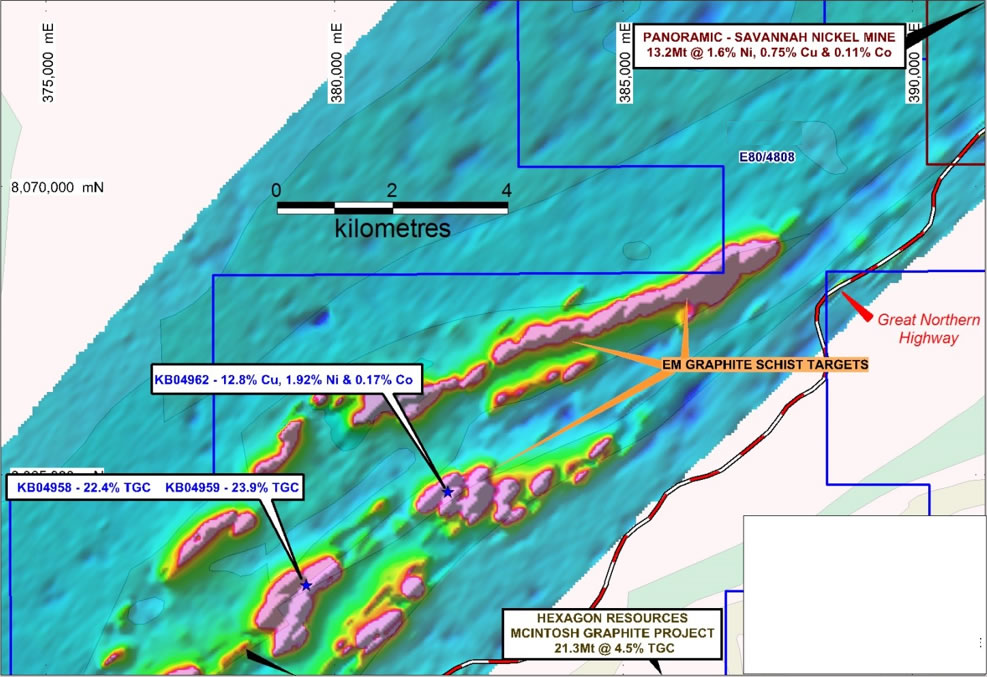McKenzie Springs Project, Western Australia
McKenzie Springs Project, Western Australia
100% owned | Savannah style Nickel, Copper, Cobalt & PGM, unencumbered exploration licence
- 14km belt of Savannah style Nickel, Copper, Cobalt and PGM prospective mafic/ultramafic rock package
- Exploration licence covering ~35km2
- Rock chip assays of gossan material to 12.8% Cu, 1.92% Ni and 0.17% Co;
- 15km strike of potential graphitic schist host units with large EM targets not drilled;
- Rock chip results to 22.4 and 23.9% TGC;
- Diamond drilling completed Dec ‘20 intersected broad disseminated zones of sulphides within mostly sedimentary granulites showing variable propylitic alteration, and lesser mafic units including amphibolites, gabbros, leucogabbros and anorthosites
- Field trip completed to define an exploration programme to begin Q2 2024 and likely to include further surface sampling and geophysics
Introduction
The McKenzie Springs Project is located in the Kimberley region of Western Australia, 85km north east of Halls Creek. Access is via the Great Northern Highway passing directly through the tenement with various 4WD pastoral tracks providing additional access.
The Project has been previously explored for nickel and base metals. The tenement hosts mafic/ultramafic intrusions that are prospective for magmatic Ni-Cu sulphide and Platinum Group Element (PGE) mineralisation. The Tickalara Metamorphic geology within the project is prospective for graphite mineralisation. Recent work including the acquisition and processing of historic airborne EM data highlight conductive stratigraphy possibly hosting substantial graphitic schist similar to Hexagon Resources’ McIntosh Graphite Project.
Reprocessed EM image showing chargeable stratigraphy
Geology
The McKenzie Springs Project falls within the Halls Creek Orogen of Upper Archaean/Lower Proterozoic age. The Halls Creek Orogen is a complex Palaeoproterozoic terrain comprising low to high grade metasedimentary and metavolcanic rocks, and voluminous granitic, mafic and mafic-ultramafic intrusions that collectively range in age from about 1910 Ma to 1790 Ma (Page et al. 1995). The Halls Creek Orogen is a well-exposed north-northeast trending orogenic belt approximately 120km long by 45km wide. The package as a whole is termed the Lamboo Complex and can be divided into three zones.
The Central Zone comprises felsic to mafic and ultramafic intrusions within high-grade metamorphic sediments and mafic units of the Tickalara Metamorphics, together with sediments of the Koongie Park Formation to the south. The Central Zone contains numerous occurrences of nickel-copper and platinum group elements, associated with the intrusive suites. The Eastern Zone comprises Halls Creek Group sediments of the Olympio and Biscay formation, broadly correlated in age with the c.1865ma Tickalara Metamorphics. These are intruded by the mafic to ultramafic Woodward Dolerite. The Eastern Zone has a number of gold occurrences. The Western Zone comprises granitic and gabbroic rock of the Paperbark Supersuite (1865-1850Ma) with the Whitewater Volcanics cropping out on its western flank. The Western Zone has a number of nickel-copper and platinum group element occurrences associated with intrusive suites.
A regional gravity high of unusually large magnitude is present when compared to other anomalies of the Australian continent, with only the Giles Complex of the Musgrave Block of comparable intensity (Hoatson and Blake 2000). This is interpreted to be related to mantle-derived magma pooled at or near the crust-mantle boundary. The various intrusions within the HCO appear to be related to this accumulation. Mafic-ultramafic intrusions are confined to the central part of the Halls Creek Orogen and crystallized at depths of between 8-23km in a variety of forms including sheets, basinal forms, funnels, plugs and multi-chambered bodies. A total of 60 intrusions have been recognized by AGSO. It is anticipated that as the geological knowledge of the area evolves, more intrusions will be identified.
SHRIMP U-Pb age dating undertaken by AGSO (Hoatson and Blake, 2000) has determined some of the major intrusions were emplaced between 1830-1856Ma. Hoatson and Blake (2000) proposed division of the mafic-ultramafic intrusives into seven groups, at least three of which are coeval, plus three other associations and undivided units.
The East Kimberley Halls Creek Orogen is widely regarded as having excellent potential for magmatic Ni-Cu sulphide and PGE mineralisation, and Hoatson and Blake (2000) considers it one of the most extensively mineralized igneous associations in Australia. Hoatson also recognized broad similarities between the HCO intrusions and the major mineralised layered intrusions at Sudbury, the Bushveld Complex and the Stillwater Complex. Two mineralised bodies of economic interest have been discovered to date within the intrusive complexes of the HCO. These include the Panton Project, with a published resource of 14.3 Mt @ 4.6g/t PGM’s and the Savannah/Savannah North Cu-Ni-Co sulphide deposits with a current resource of 13.2 Mt @ 1.6% Ni, 0.75% Cu and 0.11% Co.
The proximity of the projects to the Argyle Diamond Mine indicates a potential for further mineralisation of this type to be present. A significant gold mining tradition in the area also indicates potential for epigenetic gold mineralisation. Several sub economic Cu-Pb-Zn deposits have been identified within the Koongie Park Formation, mainly in carbonate lenses, banded ironstone and mudstone, spatially associated with felsic volcanics.
Regional Geology Map
The McKenzie Springs Project tenement lies within the Central Zone of the Halls Creek Orogen and west of the Highway Shear Zone. To the west of the Highway Shear, mafic – ultramafic lithologies of the Tickalara Metamorphics are present within structurally controlled domains. East of the structure the geology is predominantly monzogranite, granodiorite and tonalite of the Sally Downs Supersuite.
The tenement lies south along strike from the Savannah nickel mine owned by Panoramic Resources and is considered highly prospective for intrusive – hosted nickel copper mineralisation. The tenement covers two distinct mafic / ultramafic complexes – the Spring Creek and McKenzie Springs Intrusions. Hoatson and Blake (2000) correlate both intrusions with the Group V Sally Malay Intrusions. Spring Creek represents a broadly zoned, relatively undeformed intrusion, while McKenzie Springs displays a strongly fractionated sequence from peridotite – dominated lithologies in the south west to fractioned gabbro lithologies in the north east.
The majority of historical exploration has focused on the McKenzie Springs complex, where numerous copper stained gossans within pyroxenitic rocks have been explored for nickel, copper and PGE’s. Titanium oxide layers have also been historically explored within the intrusion.
The East Kimberley Halls Creek Orogen is widely regarded as having excellent potential for magmatic Ni-Cu sulphide and PGE mineralisation, and Hoatson and Blake (2000) considers it one of the most extensively mineralized igneous associations in Australia. Hoatson also recognized broad similarities between the HCO intrusions and the major mineralised layered intrusions at Sudbury, the Bushveld Complex and the Stillwater Complex.
Two mineralised bodies of economic interest have been discovered to date within the intrusive complexes of the HCO. These include the Panton Project, with a published resource of 14.3 Mt @ 4.6 g/t PGM’s and the Panoramic Savannah Nickel Mine with a Ni-Cu-Co resource of 13.2Mt @ 1.65% Ni, 0.75% Cu and 0.11% Co.








